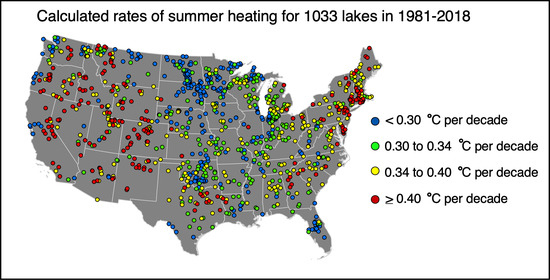Warming of Near-Surface Summer Water Temperatures in Lakes of the Conterminous United States
Abstract
1. Introduction
2. Materials and Methods
2.1. Testing Predictive Equations of Bachmann et al.
2.2. Development of New Predictive Equations for 1981–2018
2.3. Calculation of Near-Surface Water Temperatures
2.4. Calculation of Rates of Change of Lake Water Temperatures
2.5. Finding Annual Average Summer Lake Temperatures
2.6. Effects of Latitude and Elevation on Water Temperatures
3. Results
3.1. Developing Predictive Equations for the Period 1981–2018
3.2. Trends in Average Summer Water Temperatures in the Period 1981−2018
3.3. Trends in Average National Summer Air and Water Temperatures
3.4. Temperature Changes with Changes in Latitude and Elevation
4. Discussion
4.1. Predictive Equations for Summer Lake Temperatures
4.2. Trends in Average Summer Water Temperatures in the Period 1981–2018
4.3. Trends in Average Summer Air and Water Temperatures 1895–2018
4.4. Implications of Lake Warming
4.5. Methodology for Estimating Near-Surface Water Temperatures
5. Conclusions
Supplementary Materials
Author Contributions
Funding
Conflicts of Interest
References
- Magnuson, J.J.; Robertson, D.M.; Benson, B.J.; Wynne, R.H.; Livingstone, D.M.; Arai, T.; Assel, R.A.; Barry, R.G.; Card, V.; Kuusisto, E.; et al. Historical trends in lake and river ice cover in the Northern Hemisphere. Science 2000, 289, 1743–1746. [Google Scholar] [CrossRef]
- Sharma, S.; Blagrave, K.; Magnuson, J.J.; O’Reilly, C.M.; Oliver, S.; Batt, R.D.; Magee, M.R.; Straile, D.; Weyhenmeyer, G.A.; Winslow, L.; et al. Widespread loss of lake ice around the Northern Hemisphere in a warming world. Nat. Clim. Chang. 2019, 9, 227–231. [Google Scholar] [CrossRef]
- O’Reilly, C.M.; Sharma, S.; Gray, D.K.; Hampton, S.E.; Read, J.S.; Rowley, R.J.; Schneider, P.; Lenters, J.D.; McIntyre, P.B.; Kraemer, B.M.; et al. Rapid and highly variable warming of lake surface waters around the globe. Geophys. Res. Lett. 2015, 42, 10773–10781. [Google Scholar] [CrossRef]
- Woolway, R.I.; Kraemer, B.M.; Lenters, J.D.; Merchant, C.J.; O’Reilly, C.M.; Sharma, S. Global lake responses to climate change. Geophys. Res. Lett. 2020, 1, 388–403. [Google Scholar]
- Wan, W.; Zhao, L.; Xie, H.; Liu, B.; Li, H.; Cui, Y.; Ma, Y.; Hong, Y. Lake surface water temperature change over the Tibetan plateau from 2001 to 2015: A sensitive indicator of the warming climate. Geophys. Res. Lett. 2018, 45, 11–77. [Google Scholar] [CrossRef]
- Brookes, J.D.; Carey, C.C. Resilience to blooms. Science 2011, 334, 46–47. [Google Scholar] [CrossRef]
- Rigosi, A.; Hanson, P.; Hamilton, D.P.; Hipsey, M.; Rusak, J.A.; Bois, J.; Sparber, K.; Chorus, I.; Watkinson, A.J.; Qin, B.; et al. Determining the probability of cyanobacterial blooms: The application of Bayesian networks in multiple lake systems. Ecol. Appl. 2015, 25, 186–199. [Google Scholar] [CrossRef]
- Sharma, S.; Jackson, D.A.; Minns, C.K.; Shuter, B.J. Will northern fish populations be in hot water because of climate change? Glob. Chang. Biol. 2007, 13, 2052–2064. [Google Scholar] [CrossRef]
- Van Zuiden, T.M.; Chen, M.M.; Stefanoff, S.; Lopez, L.; Sharma, S. Projected impacts of climate change on three freshwater fishes and potential novel competitive interactions. Divers. Distrib. 2016, 22, 603–614. [Google Scholar] [CrossRef]
- O’Reilly, C.M.; Alin, S.R.; Plisnier, P.D.; Cohen, A.S.; McKee, B.A. Climate change decreases aquatic ecosystem productivity of Lake Tanganyika, Africa. Nature 2003, 424, 766–768. [Google Scholar] [CrossRef]
- Lehnherr, I.; Louis, V.L.S.; Sharp, M.; Gardner, A.S.; Smol, J.P.; Schiff, S.L.; Muir, D.C.; Mortimer, C.A.; Michelutti, N.; Tarnocai, C.; et al. The world’s largest High Arctic lake responds rapidly to climate warming. Nat. Commun. 2018, 9, 1–9. [Google Scholar] [CrossRef]
- Edinger, J.E.; Duttweiler, D.W.; Geyer, J.C. The response of water temperatures to meteorological conditions. Water Resour. Res. 1968, 4, 1137–1143. [Google Scholar] [CrossRef]
- Hondzo, M.; Stefan, H.G. Regional water temperature characteristics of lakes subjected to climate change. Clim. Chang. 1993, 24, 187–211. [Google Scholar] [CrossRef]
- Sharma, S.; Walker, S.C.; Jackson, D.A. Empirical modelling of lake water-temperature relationships: A comparison of approaches. Freshw. Biol. 2008, 53, 897–911. [Google Scholar] [CrossRef]
- Woolway, R.I.; Merchant, C.J.; Van Den Hoek, J.; Azorin-Molina, C.; Nõges, P.; Laas, A.; Mackay, E.B.; Jones, I.D. Northern Hemisphere atmospheric stilling accelerates lake thermal responses to a warming world. Geophys. Res. Lett. 2019, 46, 11983–11992. [Google Scholar] [CrossRef]
- Bachmann, R.W.; Sharma, S.; Canfield, D.E.; Lecours, V. The distribution and prediction of summer near-surface water temperatures in lakes of the coterminous United States and Southern Canada. Geosciences 2019, 9, 296. [Google Scholar] [CrossRef]
- Woolway, R.I.; Jones, I.D.; Maberly, S.C.; French, J.R.; Livingstone, D.M.; Monteith, D.T.; Simpson, G.L.; Thackeray, S.J.; Andersen, M.R.; Battarbee, R.W.; et al. Diel surface temperature range scales with lake size. PLoS ONE 2016, 11, e01542466. [Google Scholar] [CrossRef]
- Rose, K.C.; Winslow, L.A.; Read, J.S.; Hansen, G.J. Climate-induced warming of lakes can be either amplified or suppressed by trends in water clarity. Limnol. Oceanogr. Lett. 2016, 1, 44–53. [Google Scholar] [CrossRef]
- Peck, D.; Olsen, A.R.; Weber, M.H.; Paulsen, S.G.; Peterson, C.; Holdsworth, S.M. Survey design and extent estimates for the National Lakes Assessment. Freshw. Sci. 2013, 32, 1231–1245. [Google Scholar] [CrossRef]
- USEPA. National Lakes Assessment: A Collaborative Survey of Lakes in the United States; EPA 841-R-16-009; United States Environmental Protection Agency: Washington DC, USA, 2009. [Google Scholar]
- Piccolroaz, S.; Healey, N.C.; Lenters, J.D.; Schladow, S.G.; Hook, S.J.; Sahoo, G.B.; Toffolon, M. On the predictability of lake surface temperature using air temperature in a changing climate: A case study for Lake Tahoe (USA). Limnol. Oceanogr. 2018, 63, 243–261. [Google Scholar] [CrossRef]
- USEPA. National Lakes Assessment 2012: A Collaborative Survey of Lakes in the United States; EPA 841-R-16-113; United States Environmental Protection Agency: Washington DC, USA, 2016. [Google Scholar]
- Daly, C.M.; Halbleib, J.I.; Smith, W.P.; Gibson, M.K.; Doggett, G.H.; Taylor, J.; Curtis, P.A. Pasteris. Physiographically-sensitive mapping of temperature and precipitation across the conterminous United States. Int. J. Climatol. 2008, 28, 2031–2064. [Google Scholar] [CrossRef]
- SAS Institute. JMP Statistics and Graphics Guide, Release 14.0; SAS Institute: Cary, NC, USA, 2019. [Google Scholar]
- Dewald, T.G. Applications of the NHD at the US Environmental Protection Agency. Water Resour. Impact 2006, 8, 5–7. [Google Scholar]
- Cleveland, W.S. Robust locally weighted regression and smoothing scatterplots. J. Am. Stat. Assoc. 1979, 74, 829–836. [Google Scholar] [CrossRef]
- Haynes, W.M. CRC Handbook of Chemistry and Physics; CRC Press: Boca Raton, FL, USA, 2014. [Google Scholar]
- Lewis, W.M., Jr. The thermal regime of Lake Lanao (Philippines) and its theoretical implications for tropical lakes 1. Limnol. Oceanogr. 1973, 18, 200–217. [Google Scholar] [CrossRef]
- Adrian, R.; O’Reilly, C.M.; Zagarese, H.; Baines, S.B.; Hessen, D.O.; Keller, W.; Livingstone, D.M.; Sommaruga, R.; Straile, D.; Van Donk, E.; et al. Lakes as sentinels of climate change. Limnol. Oceanogr. 2009, 54, 2283–2297. [Google Scholar] [CrossRef]
- Winslow, L.A.; Read, J.S.; Hansen, G.J.; Rose, K.C.; Robertson, D.M. Seasonality of change: Summer warming rates do not fully represent effects of climate change on lake temperatures. Limnol. Oceanogr. 2017, 62, 2168–2178. [Google Scholar] [CrossRef]
- Lathrop, R.C.; Kasprzak, P.; Tarvainen, M.; Ventelä, A.M.; Keskinen, T.; Koschel, R.; Robertson, D.M. Seasonal epilimnetic temperature patterns and trends in a suite of lakes from Wisconsin (USA), Germany, and Finland. Inland Waters 2019, 9, 471–488. [Google Scholar] [CrossRef]
- Woolway, R.I.; Merchant, C.J. Worldwide alteration of lake mixing regimes in response to climate change. Nat. Geosci. 2019, 12, 271–276. [Google Scholar] [CrossRef]
- Donat, M.G.; King, A.D.; Overpeck, J.T.; Alexander, L.V.; Durre, I.; Karoly, D.J. Extraordinary heat during the 1930s US dust bowl and associated large-scale conditions. Clim. Dyn. 2016, 46, 413–426. [Google Scholar] [CrossRef]
- Alofs, K.M.; Jackson, D.A.; Lester, N.P. Ontario freshwater fishes demonstrate differing range-boundary shifts in a warming climate. Divers. Distrib. 2014, 20, 123–136. [Google Scholar] [CrossRef]
- Van Zuiden, T.M.; Sharma, S. Examining the influence of smallmouth bass invasion on walleye populations in Ontario lakes: Can walleye beat the heat? Divers. Distrib. 2016, 22, 1069–1079. [Google Scholar] [CrossRef]
- Sharma, S.; Vander Zanden, M.J.; Magnuson, J.J.; Lyons, J. Comparing climate change and species invasions as drivers of coldwater fish population extirpations. PLoS ONE 2011, 6, e22906. [Google Scholar] [CrossRef]
- Hansen, G.J.; Read, J.S.; Hansen, J.F.; Winslow, L.A. Projected shifts in fish species dominance in Wisconsin lakes under climate change. Glob. Chang. Biol. 2017, 23, 1463–1476. [Google Scholar] [CrossRef]
- Livingstone, D.M.; Lotter, A.F. The relationship between air and water temperatures in lakes of the Swiss Plateau: A case study with paleolimnological implications. J. Paleolimnol. 1998, 19, 191–198. [Google Scholar] [CrossRef]
- Livingstone, D.M.; Dokulil, M.T. Eighty years of spatially coherent Austrian lake surface temperatures and their relationship to regional air temperature and the North Atlantic Oscillation. Limnol. Oceanogr. 2001, 46, 1220–1227. [Google Scholar] [CrossRef]
- Toffolon, M.; Piccolroaz, S.; Majone, B.; Soja, A.M.; Peeters, F.; Schmid, M.; Wüest, A. Prediction of surface temperature in lakes with different morphology using air temperature. Limnol. Oceanogr. 2014, 59, 2185–2202. [Google Scholar] [CrossRef]
- Robertson, D.M.; Ragotzkie, R.A. Changes in the thermal structure of moderate to large sized lakes in response to changes in air temperature. Aquat. Sci. 1990, 52, 360–380. [Google Scholar] [CrossRef]
- McCombie, A.M. Some relations between air temperatures and the surface water temperatures of lakes. Limnol. Oceanogr. 1959, 4, 252–258. [Google Scholar] [CrossRef]
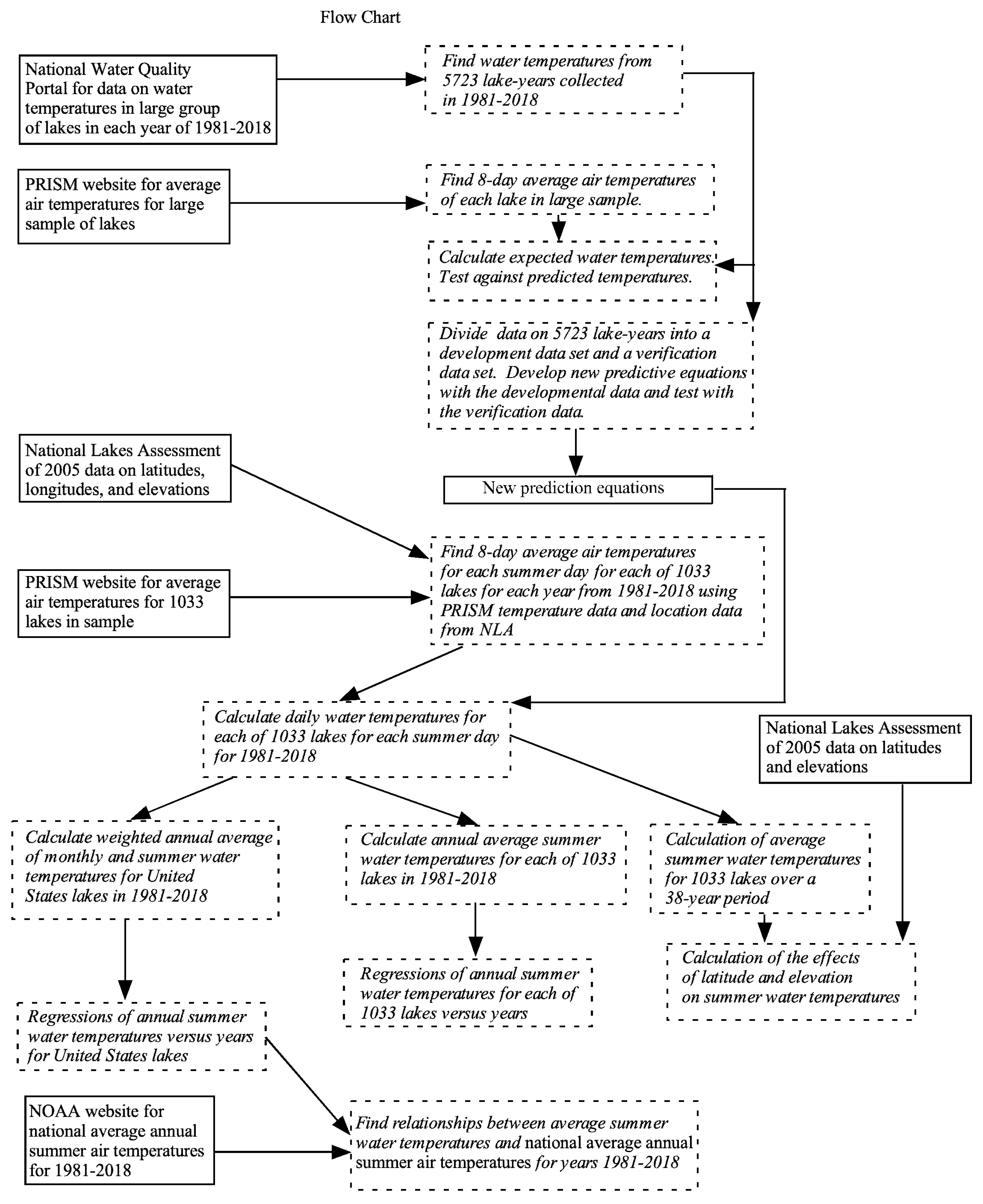
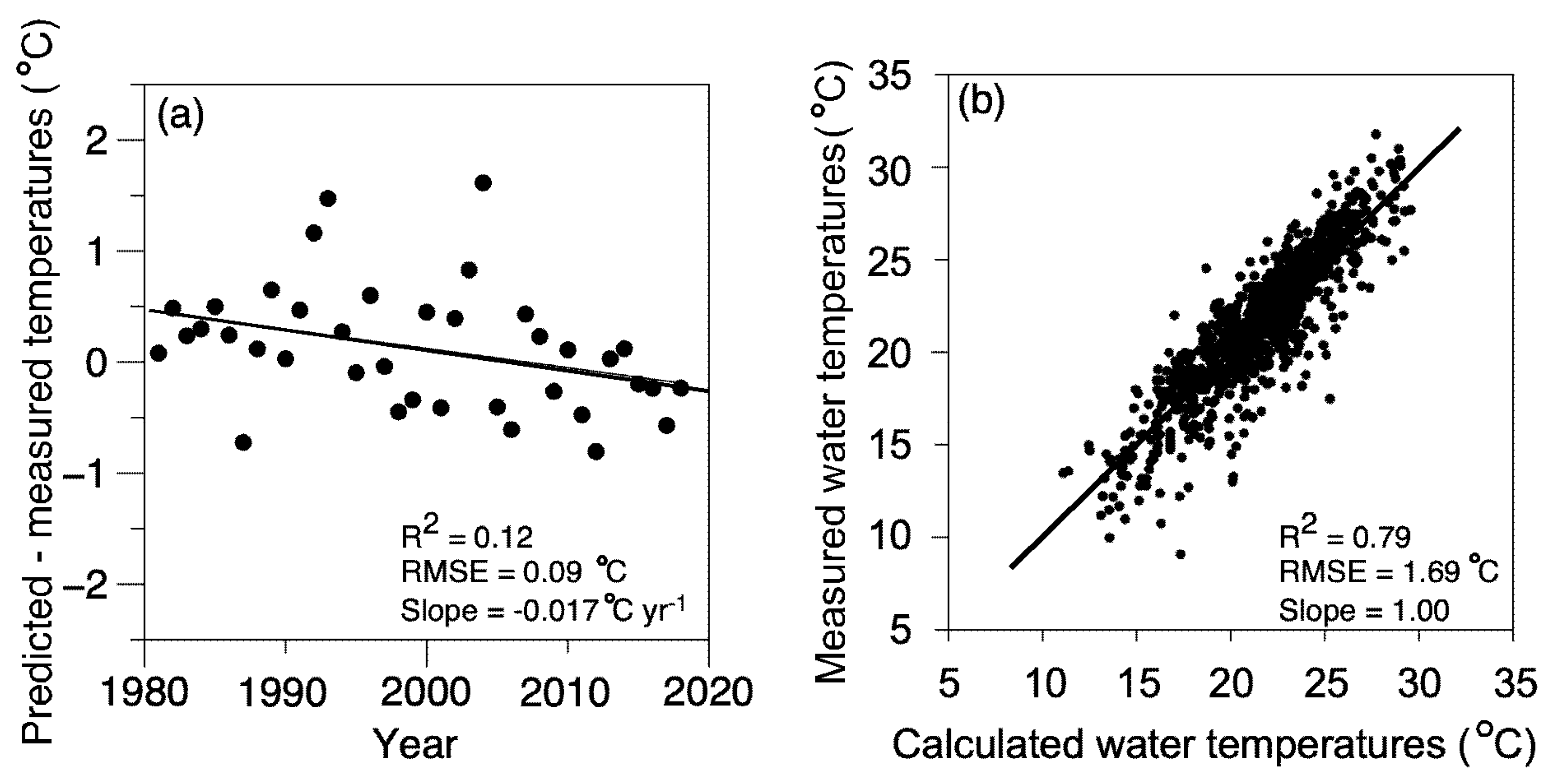
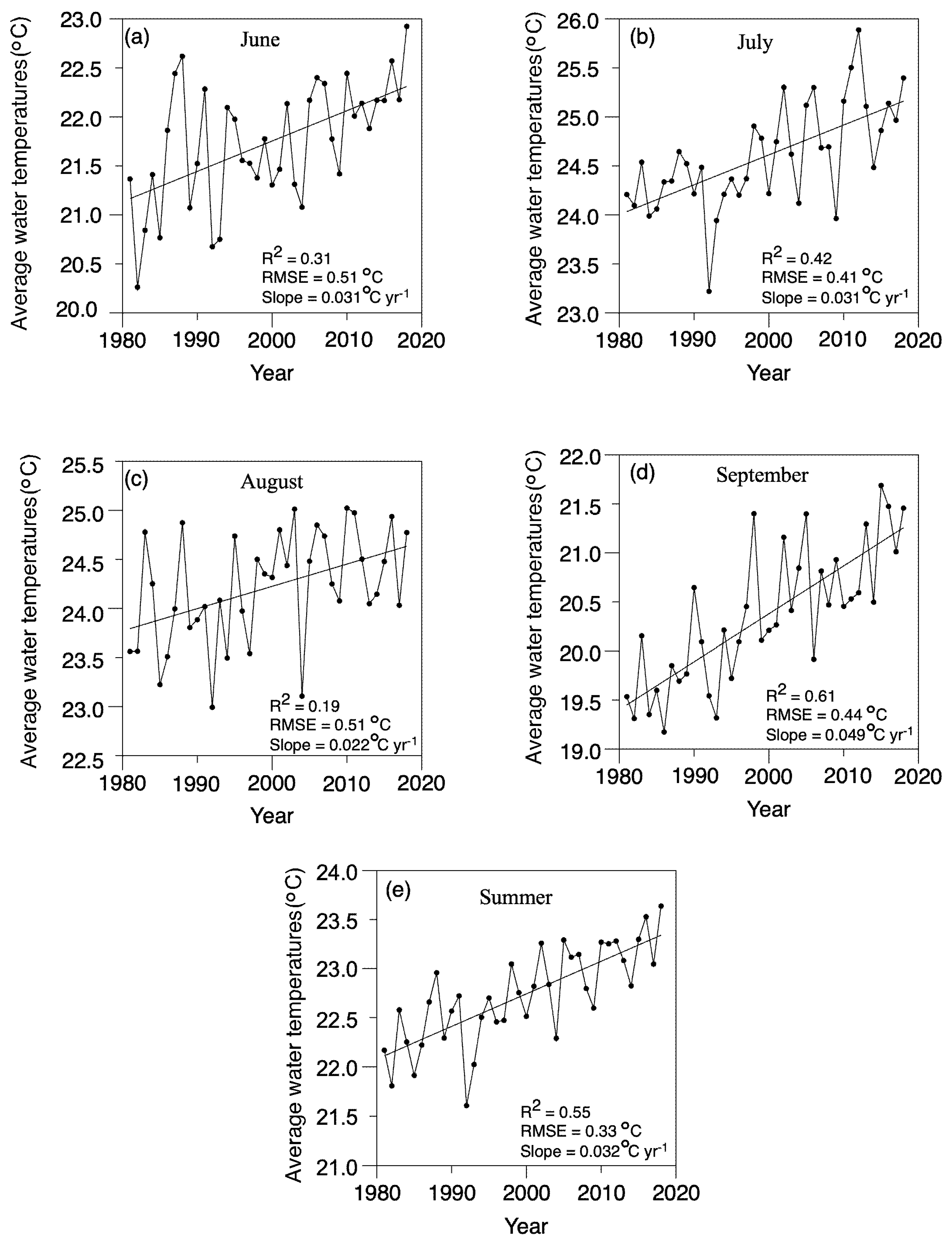

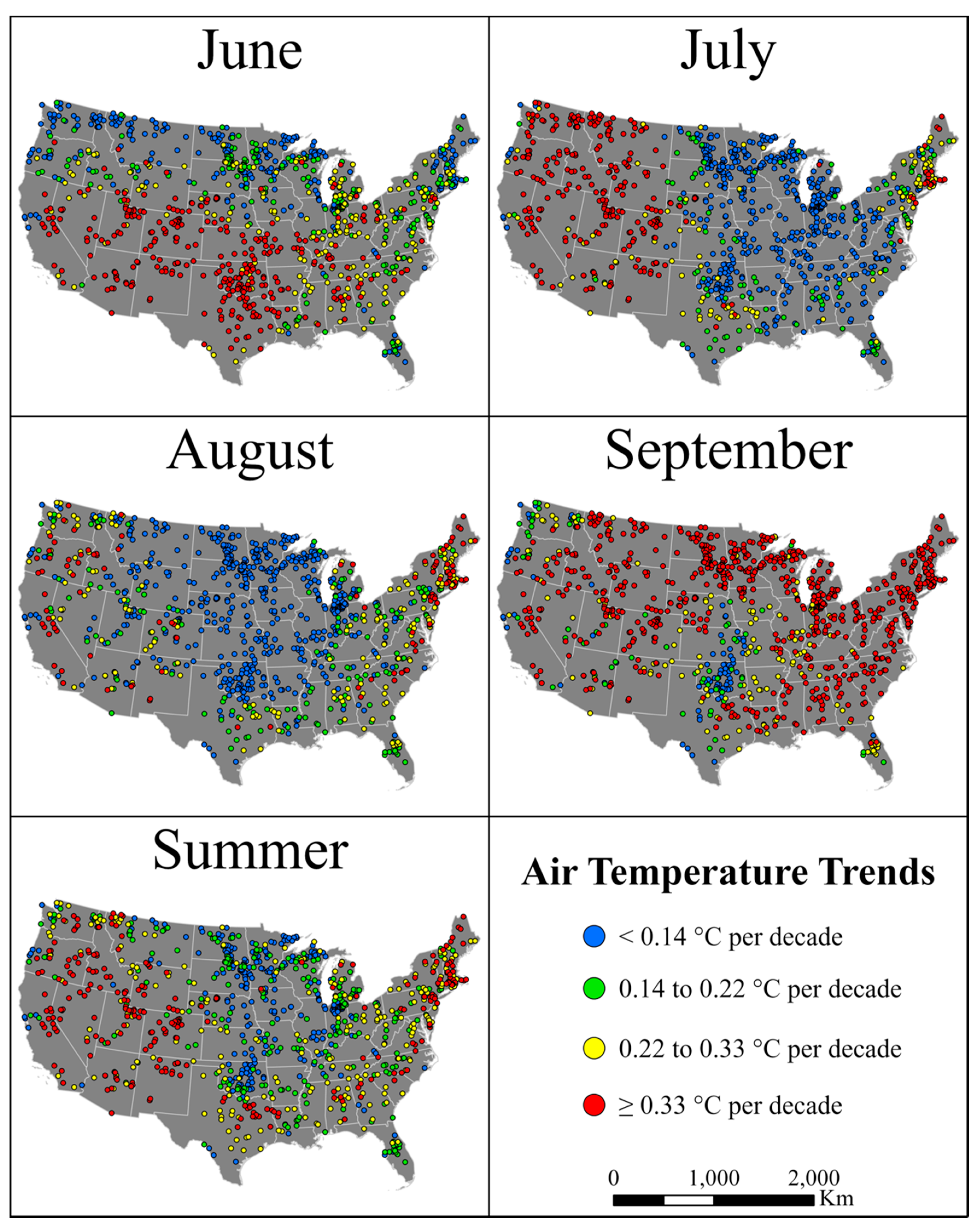
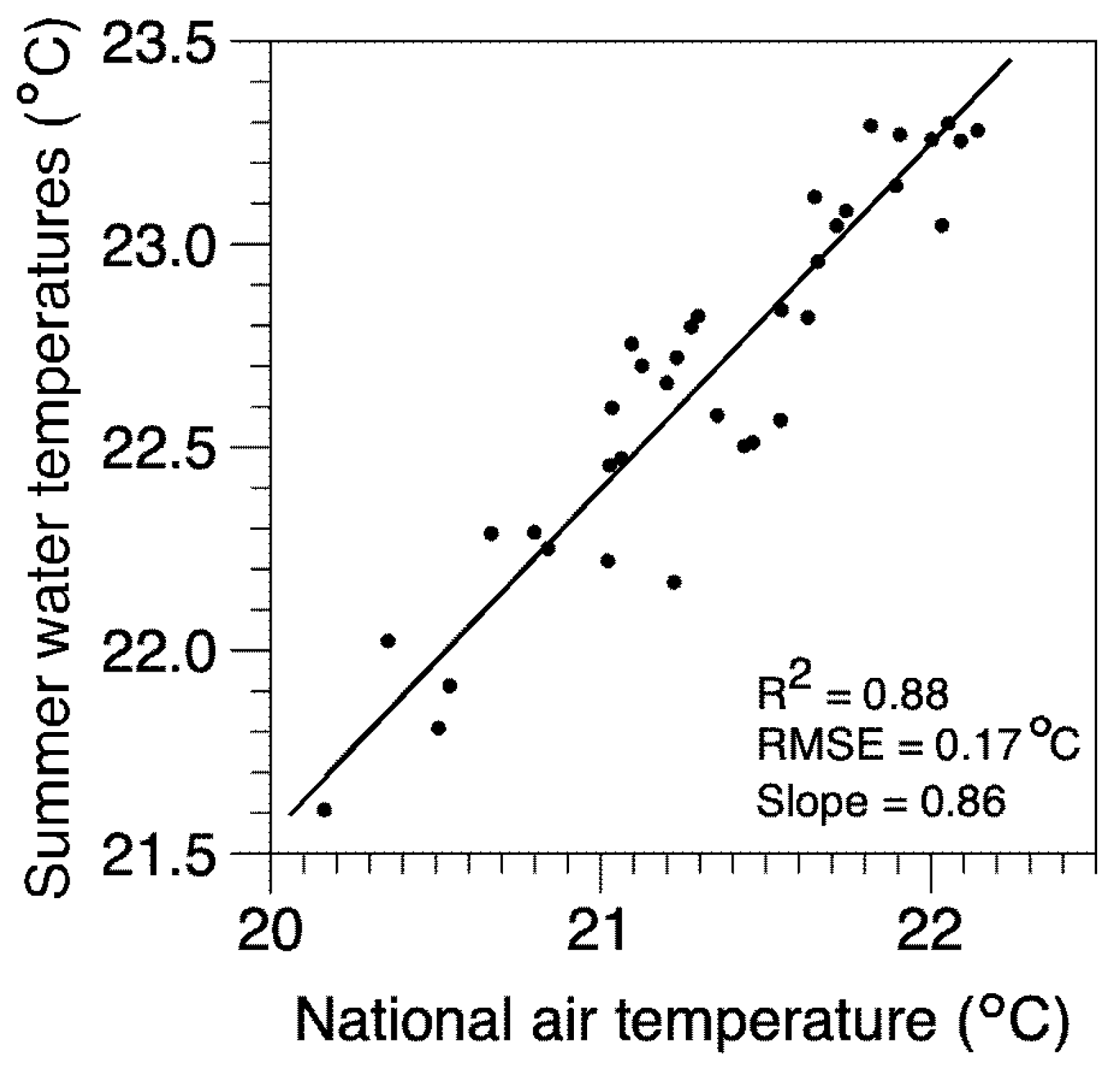
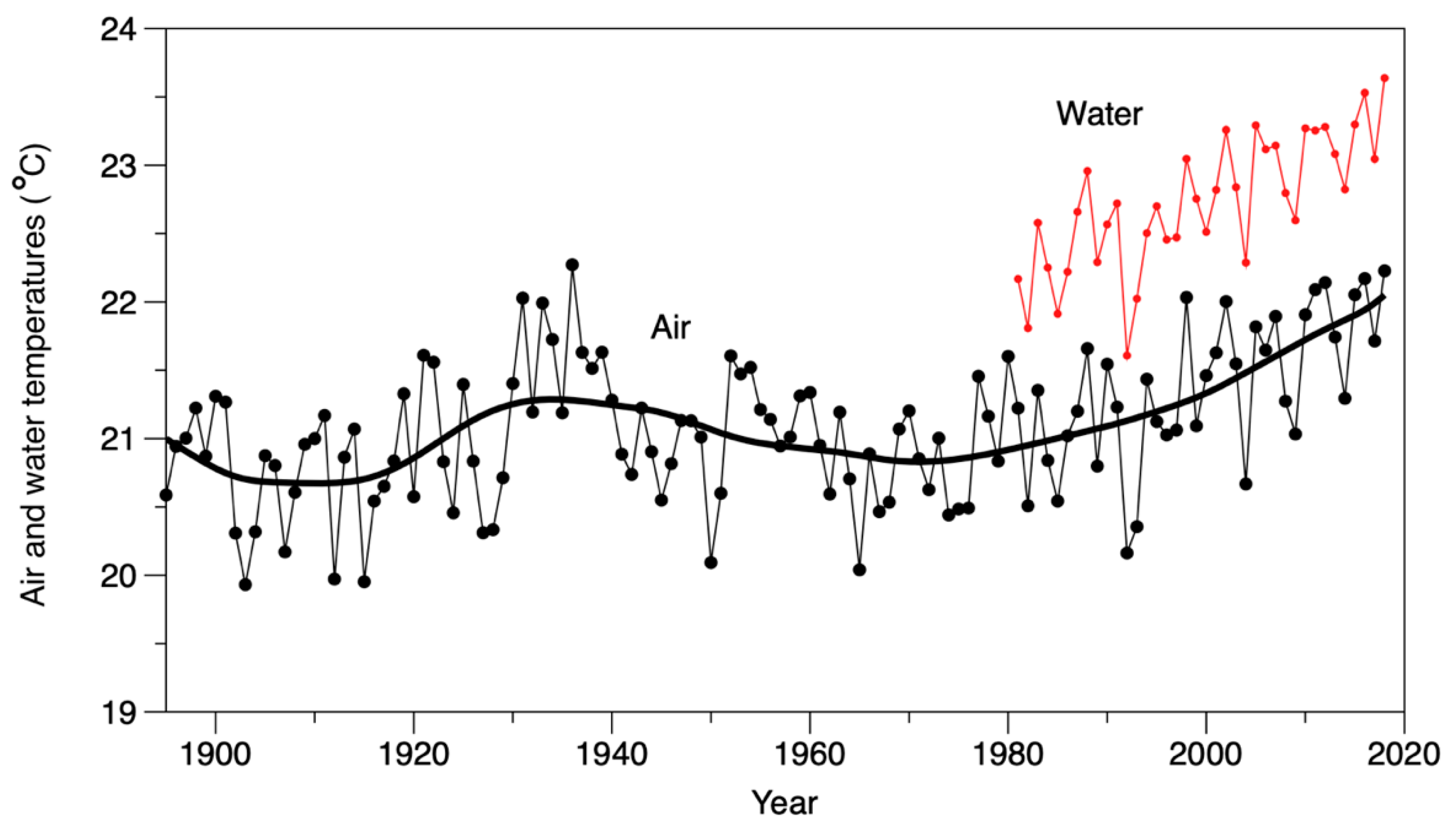
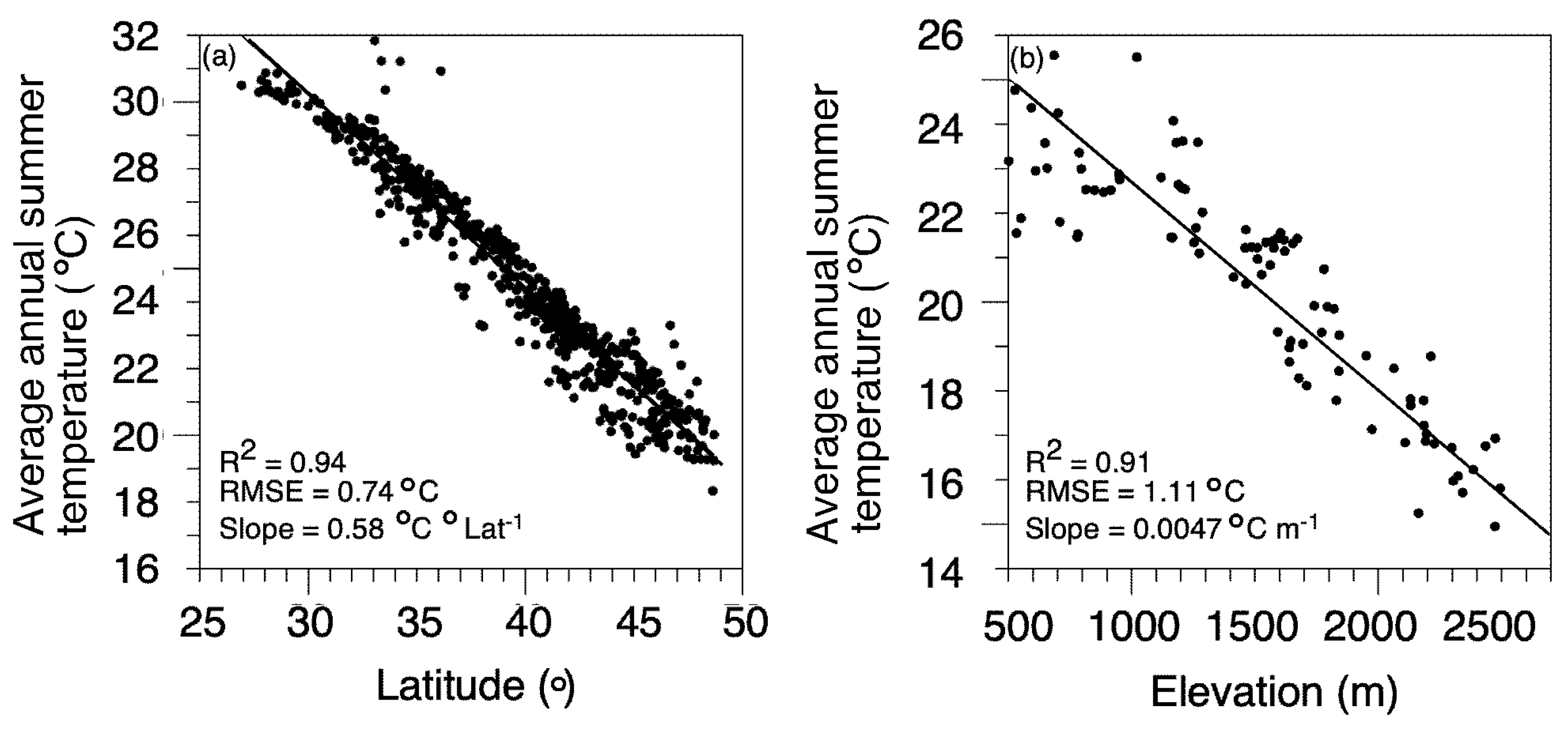
| Time Period | Rate of Change in Temperature (°C Decade−1) | Standard Error of the Mean (°C) |
|---|---|---|
| June | 0.31 | 0.08 |
| July | 0.31 | 0.06 |
| August | 0.22 | 0.08 |
| September | 0.49 | 0.07 |
| Summer (June–September) | 0.32 | 0.05 |
| June–August | 0.29 | 0.06 |
| July–September | 0.34 | 0.05 |
| July–August | 0.26 | 0.06 |
| August–September | 0.36 | 0.05 |
| June | July | August | September | Summer | |
|---|---|---|---|---|---|
| Descriptive Statistics | |||||
| Mean | 0.34 | 0.34 | 0.24 | 0.46 | 0.34 |
| Standard deviation | 0.14 | 0.14 | 0.11 | 0.07 | 0.08 |
| Standard error | 0.004 | 0.004 | 0.003 | 0.010 | 0.003 |
| Coefficient of variation | 41 | 41 | 46 | 22 | 22 |
| N | 1033 | 1033 | 1033 | 1033 | 1033 |
| Frequency Distributions | |||||
| Minimum | −0.07 | 0.01 | −0.03 | 0.04 | 0.02 |
| 10th% | 0.17 | 0.19 | 0.09 | 0.32 | 0.26 |
| 20th% | 0.23 | 0.23 | 0.14 | 0.37 | 0.28 |
| 30th% | 0.27 | 0.25 | 0.18 | 0.41 | 0.30 |
| 40th% | 0.30 | 0.28 | 0.22 | 0.44 | 0.32 |
| Median | 0.35 | 0.30 | 0.25 | 0.47 | 0.34 |
| 60th% | 0.38 | 0.34 | 0.28 | 0.49 | 0.36 |
| 70th% | 0.42 | 0.39 | 0.31 | 0.51 | 0.38 |
| 80th% | 0.45 | 0.45 | 0.34 | 0.54 | 0.41 |
| 90th% | 0.51 | 0.56 | 0.38 | 0.58 | 0.44 |
| Maximum | 0.78 | 0.87 | 0.78 | 0.81 | 0.75 |
Publisher’s Note: MDPI stays neutral with regard to jurisdictional claims in published maps and institutional affiliations. |
© 2020 by the authors. Licensee MDPI, Basel, Switzerland. This article is an open access article distributed under the terms and conditions of the Creative Commons Attribution (CC BY) license (http://creativecommons.org/licenses/by/4.0/).
Share and Cite
Bachmann, R.W.; Canfield, D.E., Jr.; Sharma, S.; Lecours, V. Warming of Near-Surface Summer Water Temperatures in Lakes of the Conterminous United States. Water 2020, 12, 3381. https://doi.org/10.3390/w12123381
Bachmann RW, Canfield DE Jr., Sharma S, Lecours V. Warming of Near-Surface Summer Water Temperatures in Lakes of the Conterminous United States. Water. 2020; 12(12):3381. https://doi.org/10.3390/w12123381
Chicago/Turabian StyleBachmann, Roger W., Daniel E. Canfield, Jr., Sapna Sharma, and Vincent Lecours. 2020. "Warming of Near-Surface Summer Water Temperatures in Lakes of the Conterminous United States" Water 12, no. 12: 3381. https://doi.org/10.3390/w12123381
APA StyleBachmann, R. W., Canfield, D. E., Jr., Sharma, S., & Lecours, V. (2020). Warming of Near-Surface Summer Water Temperatures in Lakes of the Conterminous United States. Water, 12(12), 3381. https://doi.org/10.3390/w12123381





